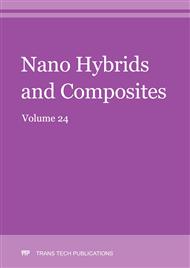[1]
X. Liu, L. Chen, A. Liu, X. Wang, Effect of nano-CaCO3 on properties of cement paste, Energy Procedia. 16 (2012) 991–996.
DOI: 10.1016/j.egypro.2012.01.158
Google Scholar
[2]
J. Chen, S-c. Kou, C-s. Poon, Hydration and properties of nano-TiO2 blended cement composites, Journal of Cement and Concrete Composites. 34 (2012) 642-649.
DOI: 10.1016/j.cemconcomp.2012.02.009
Google Scholar
[3]
S. Kawashima, P. Hou, D.J. Corr, S.P. Shah, Modification of cement-based materials with nanoparticles, Journal of Cement and Concret Composites. 36 (2013) 8-15.
DOI: 10.1016/j.cemconcomp.2012.06.012
Google Scholar
[4]
B. Lothenbach, G.Le Saout, E.Gallucci, K.Scrivener, Influence of limestone on the hydration of Portland cements, Cement and Concrete Research. 38:6 (2008) 848-860.
DOI: 10.1016/j.cemconres.2008.01.002
Google Scholar
[5]
M.S. Kırgız, Pulverized Fuel Ash Cement Activated by Nanographite, ACI Materials. 115:6 (2018a) 803-812.
DOI: 10.14359/51689101
Google Scholar
[6]
M.S. Kırgız, Green cement composite concept reinforced by graphite nano-engineered particle suspension for infrastructure renewal material, Composites Part B: Engineering. 154 (2018b) 423-429.
DOI: 10.1016/j.compositesb.2018.09.012
Google Scholar
[7]
B-W. Jo, C. H. Kim, G.H. Tae, J.B. Park, Characteristics of cement mortar with nano-SiO2 particles, Construction and Building Materials, 21:6 (2007) 1351-1355.
DOI: 10.1016/j.conbuildmat.2005.12.020
Google Scholar
[8]
M. Stefanidou, I. Papayianni, Influence of nano-SiO2 on the Portland cement pastes, Journal of Composites Part B. 43 (2012) 2706-2710.
DOI: 10.1016/j.compositesb.2011.12.015
Google Scholar
[9]
M.S. Konsta-Gdoutos, Z.S. Metaxa, S.P. Shah, Highly dispersed carbon nanotube reinforced cement based materials, Cement and Concrete Research. 40:7 (2010) 1052-1059.
DOI: 10.1016/j.cemconres.2010.02.015
Google Scholar
[10]
G. Li, Properties of high-volume fly ash concrete incorporating nano-SiO2, Journal of Cement and Concrete Research. 34:6 (2004) 1043-1049.
DOI: 10.1016/j.cemconres.2003.11.013
Google Scholar
[11]
M. Oltulu, R. Sahin, Effect of nano-SiO2, nano-Al2O3 and nano-Fe2O3 powders on compressive strengths and capillary water absorption of cement mortar containing fly ash: A comparative study, Energy and Buildings. 58 (2013) 292-301.
DOI: 10.1016/j.enbuild.2012.12.014
Google Scholar
[12]
ASTM C150–05, Standard Specification for Portland Cement, ASTM International, West Conshohocken, (2005).
Google Scholar
[13]
M.S. Kırgız, Advance Treatment by Nanographite for Portland Pulverised Fly Ash Cement (The class F) Systems, Composites Part B: Engineering. 82 (2015a) 59–71.
DOI: 10.1016/j.compositesb.2015.08.003
Google Scholar
[14]
M.S. Kırgız, Supernatant Nanographite Solution for Advance Treatment of C Class Fly Ash–Cement Systems (Part 2), ZKG International. 5 (2015b) 42-47.
Google Scholar
[15]
M.S. Kırgız, Supernatant Nanographite Solution for Advance Treatment of C Class Fly Ash–Cement Systems (Part 1), ZKG International. 4 (2015c) 56-65.
Google Scholar
[16]
M.S. Kırgız, Advances in physical properties of C class fly ash–cement systems blended nanographite (Part 2), ZKG International. 1-2 (2015d) 60-67.
Google Scholar
[17]
M.S. Kırgız, Advances in physical properties of C class fly ash–cement systems blended nanographite (Part 1), ZKG International. 12 (2014) 42-48.
Google Scholar
[18]
A. Pourjavadi, S. M. Fakoorpoor, A. Khaloo, P. Hosseini, Improving the performance of cement-based composites containing superabsorbent polymers by utilization of nano-SiO2 particles, Materials and Design. 42 (2012) 94-101.
DOI: 10.1016/j.matdes.2012.05.030
Google Scholar
[19]
J. Makar, The Effect of SWCNT and Other Nanomaterials on Cement Hydration and Reinforcement, Eds: K. Gopalakrishnan, B. Birgisson, P. Taylor and N. Attoh-Okine, Nanotechnology in Civil Infrastructure, Springer Nature Switzerland AG, 103-130, (2011).
DOI: 10.1007/978-3-642-16657-0_4
Google Scholar


